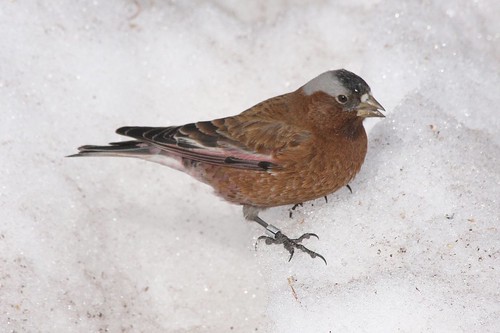 Update on the Rosy-Finches of Sandia Crest, New Mexico. The flag is waving– flocks of Rosy-Finches are still visiting the feeders at Sandia Crest House. Feeders to remain up until the end of March if bears don’t start appearing. Banding operations have been discontinued.
Update on the Rosy-Finches of Sandia Crest, New Mexico. The flag is waving– flocks of Rosy-Finches are still visiting the feeders at Sandia Crest House. Feeders to remain up until the end of March if bears don’t start appearing. Banding operations have been discontinued.
Cooperative Predation in Red-Breasted Mergansers
The Red-breasted Mergansers are still on our lake, and still cruising endlessly around its perimeter. Watching them closely caused me to form a hypothesis about their fishing technique. Is it possible that they are actually engaged in cooperative predation? This phenomena is not unusual in the animal kingdom. In Alaska, I actually watched a pod of humpback whales encircle and close in on a school of fish, then engage in a hearty feast. White Pelicans commonly do this as well, as do Harris’s Hawks and coyotes.
My reason for wondering about this is the stereotypical manner in which the flock of five mergansers circled the lake, sometimes clockwise and at other times against the clock. Almost always, one or two would lead the group, and the rest tailed off a little ways behind.
I displayed a photo of the leading duck, eyes under water, in yesterday’s blog post, which I reproduce here:
As they passed by our rear patio, the group coursed along quite rapidly, with heads or even half their bodies underwater. Suddenly, they would stop, and they would converge on a school of fish. The leading birds, which appeared to overshoot the school, would then retreat back in to join the others at the shoreline. (Of course, as I also noted, various combinations of the three species of herons would join them at that spot). The manner in which the trailing birds followed the leader was what made me realize that the group may not have simply been encountering random schools of fish. In fact, they often lined up in an irregular diagonal line, with the rearmost bird closest to the shore. Could they have been “herding” the fish?
Here are the two trailing mergansers in the group of five, mostly under water, and quite close to the shoreline. The Tricolored Heron is hurrying to keep up:

As I typed this, I thought of asking Google about it. I entered the search term “cooperative feeding in birds.” To my great surprise, one of the first hits was Cooperative feeding behavior in Red-breasted Mergansers, The Auk, October, 1965, Volume 82, number 4, Page 635, “General Notes,” in which Bayard H. Brattstrom of California State College at Fullerton made a similar observation. He stated that this behavior, while reported previously in cormorants, had never been described in mergansers.
“On the morning of 10 April 1963, at San Carlos Bay, near Guaymas, Sonora, Mexico, we saw seven Red-breasted Mergansers (Mergus serrator) behaving in a manner that suggested they were fishing cooperatively. The seven birds were feeding in a shallow arm of the bay in water less than 24 inches deep on an incoming tide. They swam in a loose line…, moving slowly, more or less in the same direction with their faces either under the surface (hunting?) or above it for short periods…
“When a hunting bird discovered a fish, it immediately gave chase, flapping its wings and running on the surface. The positions of the fish were apparently determined by the birds peering under the water at frequent intervals. As soon as one bird began a chase…, the others joined in the pursuit…, the nearby birds flapping and running along the surface, those more distant flying. In the few seconds it took the last bird to arrive, a semicircle was formed by the birds with the pursued fish in the center of the arc…
“As the birds chased the fish, one or another of them dived under the surface in pursuit, surfacing at about the time the others reached that spot. This diving continued in each case until one of the birds caught the fish. Immediately upon surfacing that bird would eat the fish. As soon as a fish was caught, the rest of the birds would begin to disperse and to hunt again. Presumably greater efficiency in fishing results from this type of cooperative feeding behavior, since a chased fish has a reduced number of escape routes, and more than one bird has the fish in vi ew at any given time…”
Photos of Late-Season Rosy-Finches
Yesterday, Jim Stuart of Albuquerque posted this note on the AZ-NM Bird List The Rosy-finches were still hitting the two feeders at Sandia Crest on Wed (26 March), perhaps 70 or so although I didn’t try to get a count. The flock seemed to cycle through about once every couple of hours. The restaurant manager kindly put a line of seed out on the deck which brought in a variety of birds plus an Abert’s squirrel for good viewing. The deck feeder tray is in a strangely awkward position for seeing anything.
All species including Hepburn’s form present. I managed to get some photos as they dashed around (see my Flickr.com link) although it was like photographing a swarm of mice. The Cox banding team seems to have gotten about every finch! If any of my ID’s on the photos are incorrect please let me know. Thanks.
Jim kindly permitted me to display several of his photos here. His birds are lined up almost as in a field guide, to permit ready comparison of plumage features. They all appear to be adult males, which makes identification easier. Early in the winter, some hatch-year birds and females can be more difficult to separate, as the gray crowns may not be as distinct and the black may not be as deep as now. Note, that as breeding season approaches, the bills of most turn from bright yellow and become darker, almost black. He certainly is right about all the bands (See: Saturation Banding)

Gray-crowned Rosy-Finch (Interior race):
Gray-crowned Rosy-Finch (Gray-cheeked Coastal or Hepburn’s race):
Black Rosy-Finch:

Brown-capped Rosy-Finch:

Florida Migration Radar
This morning, Badbirdz2 posted radar loops from late last night, showing flocks moving to Florida out of Cuba.












